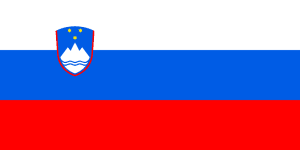
| Colors | HEX Code | RGB | CMYK |
|---|---|---|---|
| White | #FFFFFF | 255, 255, 255 | 0, 0, 0, 0 |
| Blue | #005CE5 | 0, 92, 229 | 100, 60, 0, 10 |
| Red | #FF0000 | 255, 0, 0 | 0, 100, 100, 0 |
| Yellow | #FFE500 | 255, 229, 0 | 0, 10, 100, 0 |
The flag of Slovenia has three equal horizontal bands colored white, blue, and red from top to bottom. The flag bears the coat of arms of Slovenia, which is positioned in the canton. Half of the coat of arms is on the white stripe, while the other half is on the blue stripe. The coat of arms features a shield with a blue background and a red thin border. Mount Triglav with two wavy lines is depicted over the blue background, with two wavy lines under it and three golden, six-pointed stars above the mountain.
Meaning of the Slovenian Flag
The colors of the Slovenian flag are the Pan-Slavic colors, with red symbolizing courage and revolution, white symbolizing spirituality and peace, and blue symbolizing Slavic unity and sky. The Pan-Slavic colors were adopted to show unity of the Slavic nations during the Napoleonic wars. The coat of arms represents Mount Triglav, or “three heads”, the highest peak in Slovenia. The wavy lines represent the Adriatic Sea and the local rivers of Slovenia. The three golden six-pointed stars are taken from the historical coat of arms of Slovenia, representing the Counts of Celje, a powerful Slovenian dynasty in the Medieval age.
History of the Slovenian Flag
Slovenia was part of the Austria-Hungary Empire until the end of WWI. It joined the states of Croats and Serbs to form what later was called Yugoslavia, which witnessed a lot of changes in the political structures and had struggles with the Fascist, Nazi, and Communist regimes during and after WWII. Slovenia proclaimed its independence in 1991 after fighting with Yugoslavian army. The emblem was designed in 1991, and was added to the Slovenian flag to distinguish it from the flags of Russia and Slovakia.